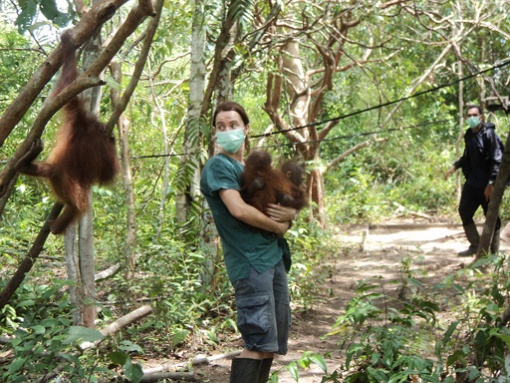In Kalimantan, orangutans still rare sight

Tender loving care: Yayasan Inisiasi Alam Rehabilitasi Indonesia (YIARI) foundation program director Karmele Liano Sánchez carries Rocky and Rikina, two orangutans who usually cling to each other, at the foundation’s center in Ketapang regency, West Kalimantan. At the center, baby orangutans are trained to scale trees and seek food. Photo Severianus Endi/The Jakarta Post
KALIMANTAN, Jan 28: Though the orangutan is a species endemic to Kalimantan, not all of the island’s residents have seen it firsthand.
Many nature lovers claim to have never come into contact with the primate, let alone ordinary people.
For Christian Willy, 17, his quest to see the ape in the wild has not yet been fruitful.
As a member of the Bentangor Volunteers for Conservation (RebonK), he and his colleagues go
to schools to speak about the integral role forest conservation plays in the protection of the orangutan’s habitat.
“But I have never met an orangutan in the wild despite my curiosity,” Willy told The Jakarta Post recently.
RebonK, which has a base in Pampang Harapan village, North Kayong regency, is a conservation organization for nature-loving youths.
The group was formed by the Palung Foundation, an NGO that focuses on orangutan conservation and is based in Ketapang regency, West Kalimantan.
Bentangor is actually the name of a type of local tree. It is also an acronym for belajar tentang orangutan, which means learning about the orangutan.
“For our campaign media, we use photos of the orangutan and sometimes videos. From them we learn about the orangutan,” said Willy, who is still in senior high school.
Nun Fausan, 21, another RebonK member, has a similar experience. Despite often exploring the orangutan’s natural habitat in the Lubuk Baji protected forest with his group, luck has never been on his side.
“I think it’s funny. We often roam into the forest and conduct campaigns on orangutan conservation in schools, but we have never run into them,” said Fausan.
A similar group formed by Palung Foundation, which is based in Ketapang city, is the Taruna Jaga Alam (Tajam). Unlike Fausan, Tajam member Banu Uti Wahyudi, 22, can proudly say he has seen orangutans on seven occasions in their natural habitat, albeit from a distance of around 20 meters.
“I’ve never met them in close proximity. They are always on top of trees and hiding behind the foliage,” said Banu.
Together with his colleagues, Banu occasionally roams around Lubuk Baji and Gunung Pramas in North Kayong regency. During each trip, they record orangutan nests, tracks and droppings.
“An indicator of a successful survey is seeing the orangutan and observing its nest, tracks and droppings,” said Banu.
Conducting a survey requires considerable knowledge of orangutans. Explorers must not make any noise, as wild orangutans are afraid of humans.
There is also a potential threat to meet the mandar, a local term for older, aggressive orangutans. Mandar build nests no more than 3 meters from the ground, because they are unable to climb higher.
“If they feel threatened, they could attack,” said Banu.
Orangutans build their nests from twigs and leaves on sturdy branches. When it rains, they cover their heads with leaves and branches.
Five types of nests have been identified. The type A nest is a new nest, evidenced by leaves that are still green, estimated to have been built between three and four days before.
“Orangutans build nests every day, although they may likely return to their old nests after searching for food,” said Banu.
The type B nest is estimated to have been occupied for around a week and the dry leaves are a sign that the type C nest has been occupied for a month or so. The type D nest is when the leaves have dried up and dwindled, while the type E nest has no leaves and only dry twigs remain.
“Most of us have found the type C nests. I have never found a type A nest and only came across a type B once,” said Banu.
Yopri, a nature photographer in Ketapang, said he had seen orangutans four times from a distance of roughly 8 m. He was lucky to stumble upon the orangutans in Pematang Gadung peat swamp, located some 30 kilometers from Ketapang.
“I have only ever seen them in the trees — never on the ground,” said Yopri.
He added that a strategy in order to catch a glimpse of the orangutan was to recognize and record the location of food sources. When the trees bear fruit, the orangutans will seek out the fruit alone or in a group.
source: The Jakarta Post








